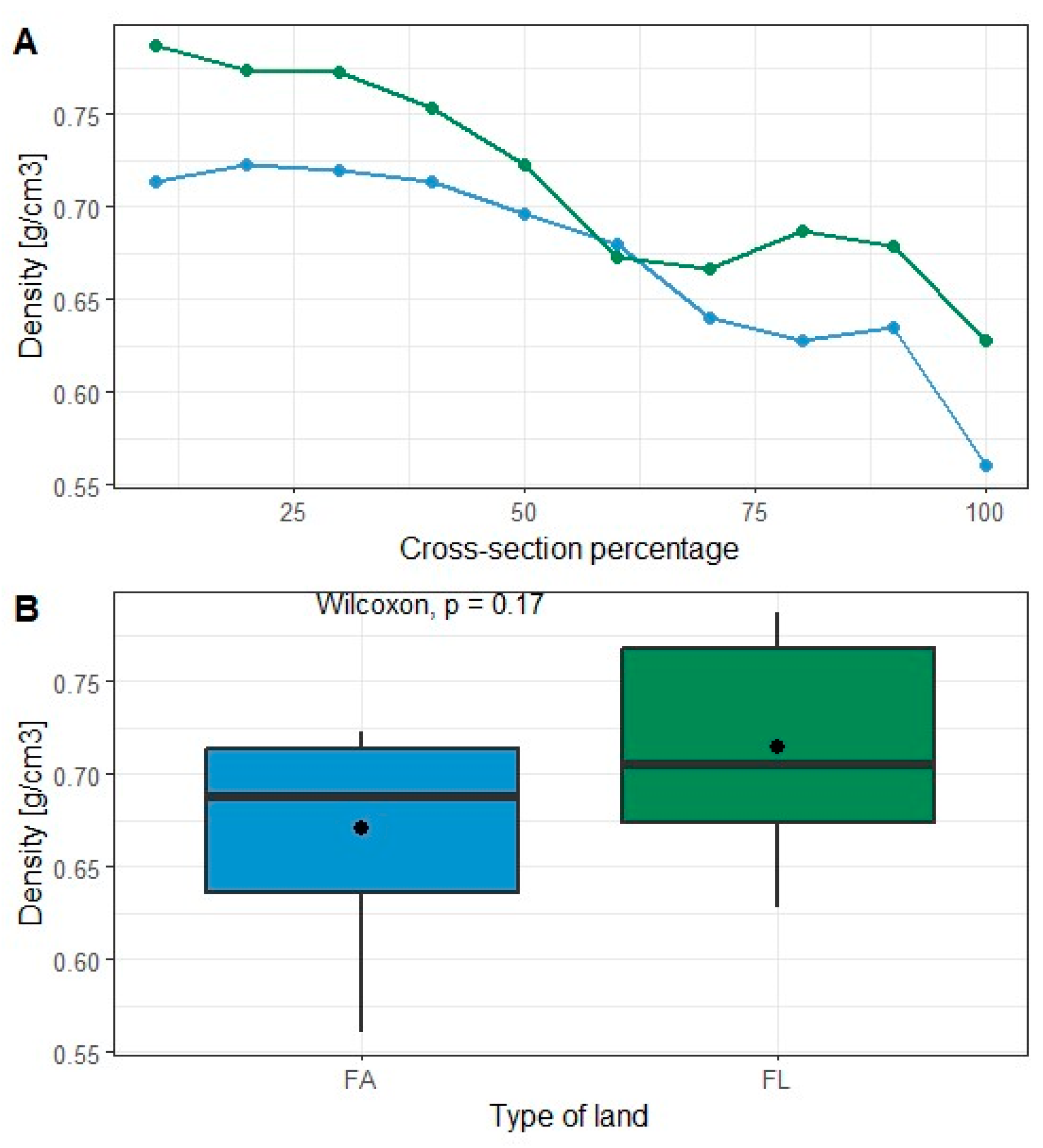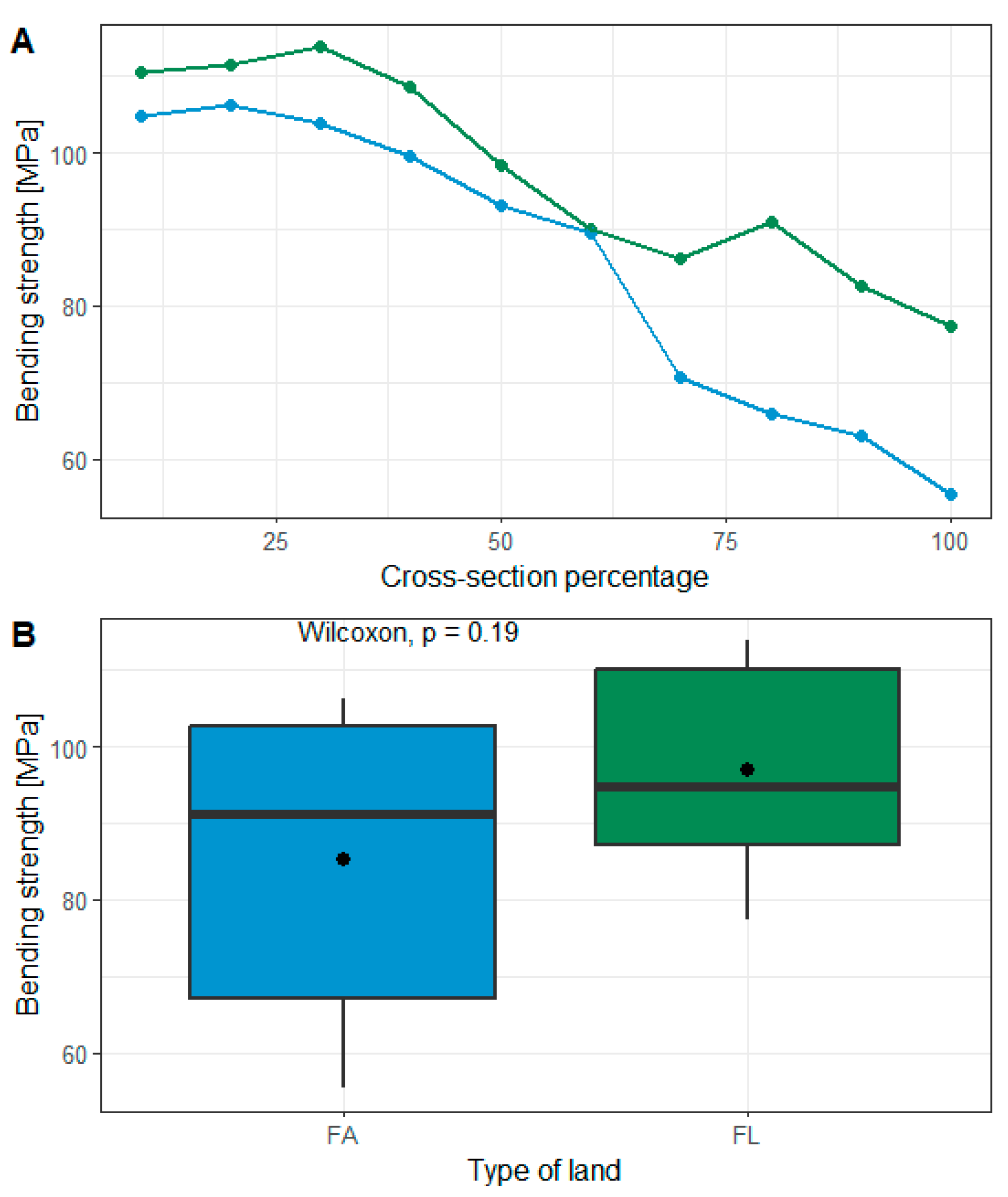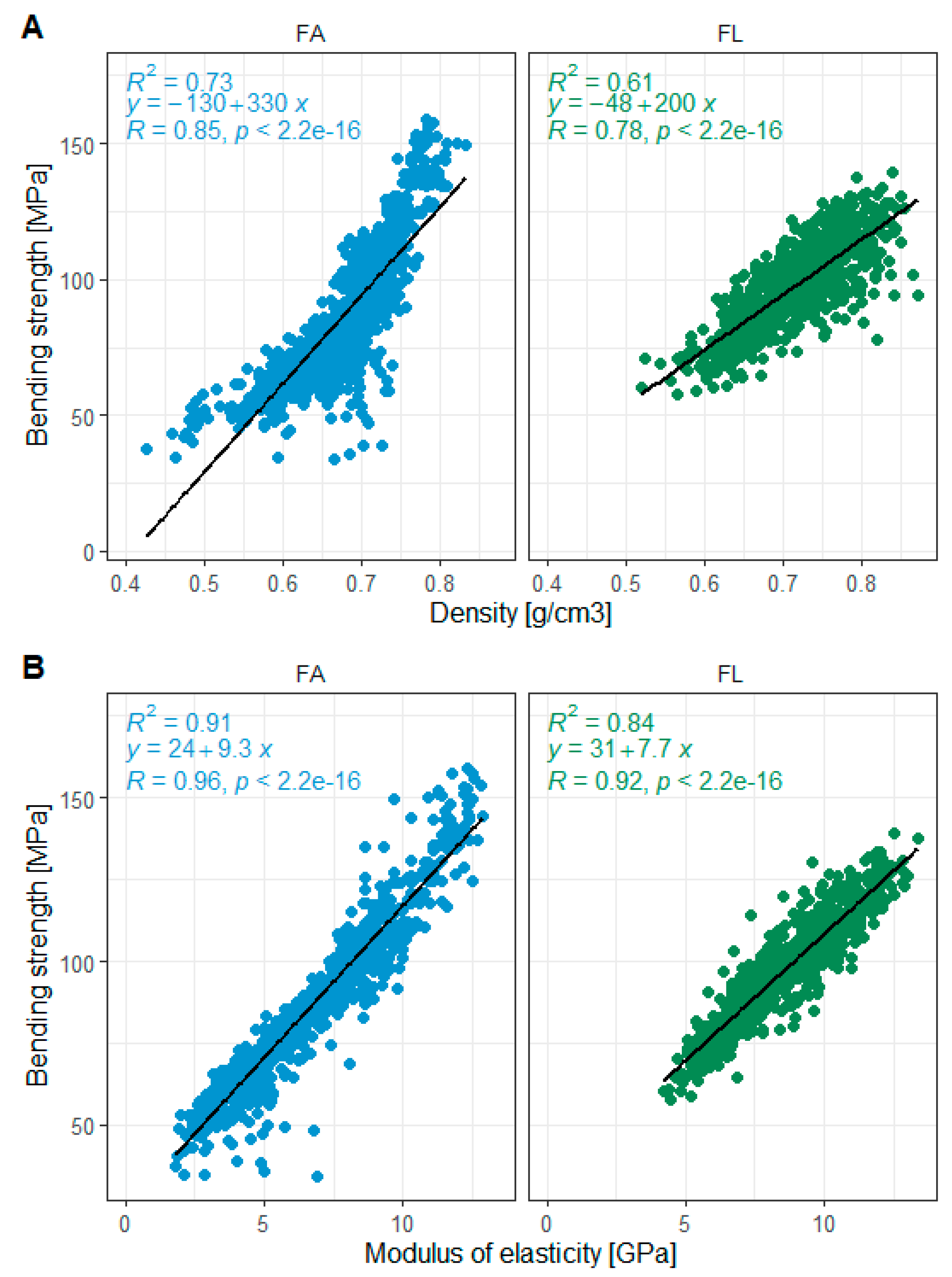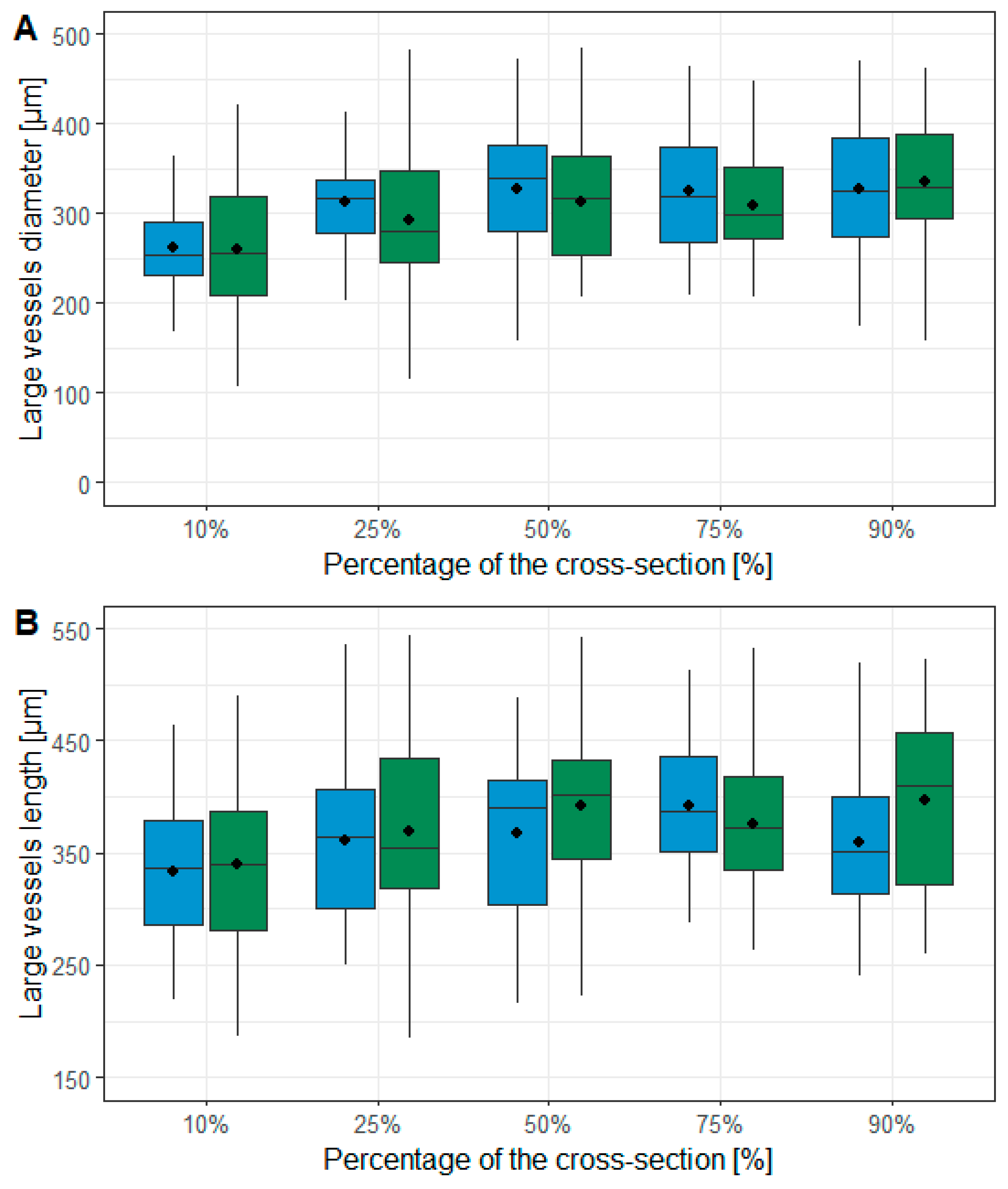Wood Quality of Pendulate Oak on Post-Agricultural Land: A Case Study Based on Physico-Mechanical and Anatomical Properties
Abstract
1. Introduction
- (i)
- Wood originating from post-agricultural land will demonstrate physico-mechanical properties that are different to wood from forest land;
- (ii)
- There will not be a difference between vessels and fiber dimensions between samples from the forest and former agricultural land;
- (iii)
- Changes in wood properties on the cross-section of the trunk will not be comparable for both types of land, especially close to the pith zone.
2. Materials and Methods
2.1. Study Site
2.2. Data Collection
2.2.1. Tree Selection
2.2.2. Collecting and Preparing Research Material
2.2.3. The Evaluation of Annual Ring Growth and Anatomical Structure
2.2.4. Chemical Composition
2.2.5. Measurements of Physical and Mechanical Properties
- WD—wood density [g/cm3];
- m—mass of wood sample [g];
- V—volume of the sample [cm3].
2.2.6. Testing Mechanical Properties
2.3. Data Analyses
3. Results
3.1. Physical and Mechanical Properties
3.2. Relationship between Physical and Mechanical Properties
3.3. Annual Ring Width
3.4. Anatomical and Chemical Characteristics of Wood
3.4.1. Vessel Characteristics
3.4.2. Fiber Characteristics
3.4.3. Chemical Composition
4. Discussion
5. Conclusions
Author Contributions
Funding
Data Availability Statement
Acknowledgments
Conflicts of Interest
References
- Václav, K.; Richard, P. The Level of the Wood Raw Material Base Processing in the Czech Republic. Procedia Econ. Financ. 2015, 34, 557–564. [Google Scholar] [CrossRef]
- Sandberg, D.; Kutnar, A.; Mantanis, G. Wood Modification Technologies-a Review. Iforest-Biogeosci. For. 2017, 10, 895. [Google Scholar] [CrossRef]
- Gazull, L.; Gautier, D. Woodfuel in a Global Change Context. Wiley Interdiscip. Rev. Energy Environ. 2015, 4, 156–170. [Google Scholar] [CrossRef]
- Oosawa, K.; Kanematsu, Y.; Kikuchi, Y. Forestry and Wood Industry. Energy Technol. Roadmaps Jpn. Future Energy Syst. Based Feasible Technol. Beyond 2016, 2030, 391–403. [Google Scholar]
- FAO. Global Forest Resources Assessment 2020 (FRA 2020), Food and Agricultural Organization of the United Nations; FAO: Rome, Italy, 2020. [Google Scholar]
- Keenan, R.J.; Reams, G.A.; Achard, F.; de Freitas, J.V.; Grainger, A.; Lindquist, E. Dynamics of Global Forest Area: Results from the FAO Global Forest Resources Assessment 2015. For. Ecol. Manag. 2015, 352, 9–20. [Google Scholar] [CrossRef]
- Campbell, J.E.; Lobell, D.B.; Genova, R.C.; Field, C.B. The Global Potential of Bioenergy on Abandoned Agriculture Lands. Environ. Sci. Technol. 2008, 42, 5791–5794. [Google Scholar] [CrossRef]
- Ranacher, L.; Sedmik, A.; Schwarzbauer, P. Public Perceptions of Forestry and the Forest-Based Bioeconomy in the European Union; EFI: Joensu, Finladn, 2020; ISBN 952598026X. [Google Scholar]
- Gundersen, V.; Vistad, O.I.; Skjeggedal, T. Forest Owners’ Perspectives on Forest Protection in Norway. Scand. J. For. Res. 2022, 37, 276–286. [Google Scholar] [CrossRef]
- Seidl, R.; Thom, D.; Kautz, M.; Martin-Benito, D.; Peltoniemi, M.; Vacchiano, G.; Wild, J.; Ascoli, D.; Petr, M.; Honkaniemi, J.; et al. Forest Disturbances under Climate Change. Nat. Clim. Change 2017, 7, 395–402. [Google Scholar] [CrossRef]
- Patacca, M.; Lindner, M.; Lucas-Borja, M.E.; Cordonnier, T.; Fidej, G.; Gardiner, B.; Hauf, Y.; Jasinevičius, G.; Labonne, S.; Linkevičius, E.; et al. Significant Increase in Natural Disturbance Impacts on European Forests since 1950. Glob. Chang. Biol. 2023, 29, 1359–1376. [Google Scholar] [CrossRef]
- Kauppi, P.E.; Stål, G.; Arnesson-Ceder, L.; Hallberg Sramek, I.; Hoen, H.F.; Svensson, A.; Wernick, I.K.; Högberg, P.; Lundmark, T.; Nordin, A. Managing Existing Forests Can Mitigate Climate Change. For. Ecol. Manag. 2022, 513, 120186. [Google Scholar] [CrossRef]
- Nepal, P.; Johnston, C.M.T.; Ganguly, I. Effects on Global Forests and Wood Product Markets of Increased Demand for Mass Timber. Sustainability 2021, 13, 13943. [Google Scholar] [CrossRef]
- Icka, P.; Damo, R.; Icka, E. Paulownia Tomentosa, a Fast Growing Timber. Ann. ”Valahia” Univ. Targoviste Agric. 2016, 10, 14–19. [Google Scholar] [CrossRef]
- Bredemeier, M.; Busch, G.; Hartmann, L.; Jansen, M.; Richter, F.; Lamersdorf, N.P. Fast Growing Plantations for Wood Production–Integration of Ecological Effects and Economic Perspectives. Front. Bioeng. Biotechnol. 2015, 3, 72. [Google Scholar] [CrossRef] [PubMed]
- Daugaviete, M.; Makovskis, K.; Lazdins, A.; Lazdina, D. Suitability of Fast-Growing Tree Species (Salix spp., Populus spp., Alnus spp.) for the Establishment of Economic Agroforestry Zones for Biomass Energy in the Baltic Sea Region. Sustainability 2022, 14, 16564. [Google Scholar] [CrossRef]
- Thomas, A.; Priault, P.; Piutti, S.; Dallé, E.; Marron, N. Growth Dynamics of Fast-Growing Tree Species in Mixed Forestry and Agroforestry Plantations. For. Ecol. Manag. 2021, 480, 118672. [Google Scholar] [CrossRef]
- Marada, P.; Cukor, J.; Kuběnka, M.; Linda, R.; Vacek, Z.; Vacek, S. New Agri-Environmental Measures Have a Direct Effect on Wildlife and Economy on Conventional Agricultural Land. PeerJ 2023, 11, e15000. [Google Scholar] [CrossRef] [PubMed]
- Mola-Yudego, B.; Arevalo, J.; Díaz-Yáñez, O.; Dimitriou, I.; Freshwater, E.; Haapala, A.; Khanam, T.; Selkimäki, M. Reviewing Wood Biomass Potentials for Energy in Europe: The Role of Forests and Fast Growing Plantations. Biofuels 2017, 8, 401–410. [Google Scholar] [CrossRef]
- Cukor, J.; Vacek, Z.; Vacek, S.; Linda, R.; Podrázský, V. Biomass Productivity, Forest Stability, Carbon Balance, and Soil Transformation of Agricultural Land Afforestation: A Case Study of Suitability of Native Tree Species in the Submontane Zone in Czechia. Catena 2022, 210, 105893. [Google Scholar] [CrossRef]
- Zeidler, A.; Borůvka, V.; Brabec, P.; Tomczak, K.; Bedřich, J.; Vacek, Z.; Cukor, J.; Vacek, S. The Possibility of Using Non-Native Spruces for Norway Spruce Wood Replacement—A Case Study from the Czech Republic. Forests 2024, 15, 255. [Google Scholar] [CrossRef]
- Zasada, M.; Bijak, S.; Bronisz, K.; Bronisz, A.; Gawęda, T. Biomass Dynamics in Young Silver Birch Stands on Post-Agricultural Lands in Central Poland. Drewno 2014, 57, 29–39. [Google Scholar] [CrossRef]
- Fayet, C.M.J.; Reilly, K.H.; Van Ham, C.; Verburg, P.H. What Is the Future of Abandoned Agricultural Lands? A Systematic Review of Alternative Trajectories in Europe. Land Use Policy 2022, 112, 105833. [Google Scholar] [CrossRef]
- Ruskule, A.; Nikodemus, O.; Kasparinska, Z.; Kasparinskis, R.; Brūmelis, G. Patterns of Afforestation on Abandoned Agriculture Land in Latvia. Agrofor. Syst. 2012, 85, 215–231. [Google Scholar] [CrossRef]
- Holubík, O.; Podrázský, V.; Vopravil, J.; Khel, T.; Remeš, J. Effect of Agricultural Lands Afforestation and Tree Species Composition on the Soil Reaction, Total Organic Carbon and Nitrogen Content in the Uppermost Mineral Soil Profile. Soil Water Res. 2014, 9, 192–200. [Google Scholar] [CrossRef]
- Löf, M.; Thomsen, A.; Madsen, P. Sowing and Transplanting of Broadleaves (Fagus sylvatica L., Quercus robur L., Prunus avium L. and Crataegus monogyna Jacq.) for Afforestation of Farmland. For. Ecol. Manag. 2004, 188, 113–123. [Google Scholar] [CrossRef]
- Tomczak, K.; Mania, P.; Tomczak, A. Quality of Beech, Birch and Oak Wood from Stands Growing on Post-Agricultural Lands. Wood Res. 2023, 68, 279–292. [Google Scholar] [CrossRef]
- Lutter, R.; Tullus, A.; Kanal, A.; Tullus, T.; Vares, A.; Tullus, H. Growth Development and Plant–Soil Relations in Midterm Silver Birch (Betula Pendula Roth) Plantations on Previous Agricultural Lands in Hemiboreal Estonia. Eur. J. For. Res. 2015, 134, 653–667. [Google Scholar] [CrossRef]
- Rytter, L.; Lutter, R. Early Growth of Different Tree Species on Agricultural Land along a Latitudinal Transect in Sweden. For. Int. J. For. Res. 2019, 93, 376–388. [Google Scholar] [CrossRef]
- Fahlvik, N.; Rytter, L.; Stener, L.G. Production of Hybrid Aspen on Agricultural Land during One Rotation in Southern Sweden. J. For. Res. 2021, 32, 181–189. [Google Scholar] [CrossRef]
- Soliño, M.; Oviedo, J.L.; Caparrós, A. Are Forest Landowners Ready for Woody Energy Crops? Preferences for Afforestation Programs in Southern Spain. Energy Econ. 2018, 73, 239–247. [Google Scholar] [CrossRef]
- Vacek, Z.; Vacek, S.; Cukor, J. European Forests under Global Climate Change: Review of Tree Growth Processes, Crises and Management Strategies. J. Environ. Manag. 2023, 332, 117353. [Google Scholar] [CrossRef]
- Thurm, E.A.; Hernandez, L.; Baltensweiler, A.; Ayan, S.; Rasztovits, E.; Bielak, K.; Zlatanov, T.M.; Hladnik, D.; Balic, B.; Freudenschuss, A.; et al. Alternative Tree Species under Climate Warming in Managed European Forests. For. Ecol. Manag. 2018, 430, 485–497. [Google Scholar] [CrossRef]
- Vitasse, Y.; Bottero, A.; Cailleret, M.; Bigler, C.; Fonti, P.; Gessler, A.; Lévesque, M.; Rohner, B.; Weber, P.; Rigling, A.; et al. Contrasting Resistance and Resilience to Extreme Drought and Late Spring Frost in Five Major European Tree Species. Glob. Chang. Biol. 2019, 25, 3781–3792. [Google Scholar] [CrossRef] [PubMed]
- Johansson, T. Total Stem and Merchantable Volume Equations of Norway Spruce (Picea abies (L.) Karst.) Growing on Former Farmland in Sweden. Forests 2014, 5, 2037–2049. [Google Scholar] [CrossRef]
- Johansson, T. Biomass Production of Norway Spruce (Picea abies (L.) Karst.) Growing on Abandoned Farmland. Silva Fenn. 1999, 33, 261–280. [Google Scholar] [CrossRef]
- Jelonek, T.; Arasimowicz-Jelonek, M.; Gzyl, J.; Tomczak, A.; Łakomy, P.; Grzywiński, W.; Remlein, A.; Klimek, K.; Kopaczyk, J.; Jaszczak, R.; et al. Influence of Former Farmland on the Characteristics and Properties of Scots Pine (Pinus sylvestris L.) Tree Tissue. Bioresources 2019, 14, 3247–3265. [Google Scholar] [CrossRef]
- Kozakiewicz, P.; Jankowska, A.; Mamiński, M.; Marciszewska, K.; Ciurzycki, W.; Tulik, M. The Wood of Scots Pine (Pinus sylvestris L.) from Post-Agricultural Lands Has Suitable Properties for the Timber Industry. Forests 2020, 11, 1033. [Google Scholar] [CrossRef]
- Cukor, J.; Zeidler, A.; Vacek, Z.; Vacek, S.; Šimůnek, V.; Gallo, J. Comparison of Growth and Wood Quality of Norway Spruce and European Larch: Effect of Previous Land Use. Eur. J. For. Res. 2020, 139, 459–472. [Google Scholar] [CrossRef]
- Zeidler, A.; Vacek, Z.; Cukor, J.; Vlastimil, B.; Vacek, S.; Prokupova, A.; Linda, R.; Vacek, O. Is European Larch (Larix decidua Mill.) a Suitable Substitute for Norway Spruce (Picea abies (L.) Karst.) for Agricultural Land Afforestation? For. Ecol. Manag. 2022, 517, 120257. [Google Scholar] [CrossRef]
- Zeidler, A.; Borůvka, V.; Schönfelder, O. Comparison of Wood Quality of Douglas Fir and Spruce from Afforested Agricultural Land and Permanent Forest Land in the Czech Republic. Forests 2017, 9, 13. [Google Scholar] [CrossRef]
- Vacek, Z.; Bílek, L.; Remeš, J.; Vacek, S.; Cukor, J.; Gallo, J.; Šimůnek, V. Afforestation Suitability and Production Potential of Five Tree Species on Abandoned Farmland in Response to Climate Change, Czech Republic. Trees 2022, 36, 1369–1385. [Google Scholar] [CrossRef]
- Liepiņš, K.; Rieksts-Riekstiņš, J. Stemwood Density of Juvenile Silver Birch Trees (Betula Pendula Roth) from Plantations on Former Farmlands. Balt. For. 2013, 19, 179–186. [Google Scholar]
- Tomczak, K.; Kopacz, J.; Jelonek, T.; Tomczak, A. Wood Quality of Silver Birch Betula Pendula Roth Stands Growing on Former Agricultural Lands in Poland. Sylwan 2023, 167, 427–439. [Google Scholar]
- Kuznetsova, T.; Lukjanova, A.; Mandre, M.; Lõhmus, K. Aboveground Biomass and Nutrient Accumulation Dynamics in Young Black Alder, Silver Birch and Scots Pine Plantations on Reclaimed Oil Shale Mining Areas in Estonia. For. Ecol. Manag. 2011, 262, 56–64. [Google Scholar] [CrossRef]
- Tomczak, K.; Mania, P.; Tomczak, A. Wood Density and Annual Ring Width of Pedunculate Oak from Stands Grown on Former Agricultural Land. Wood Res. 2022, 67, 718–730. [Google Scholar] [CrossRef]
- Robert, E.M.R.; Mencuccini, M.; Martínez-Vilalta, J. The Anatomy and Functioning of the Xylem in Oaks. In Oaks Physiological Ecology. Exploring the Functional Diversity of Genus Quercus L.; Springer: Berlin/Heidelberg, Germany, 2017; pp. 261–302. [Google Scholar]
- Longuetaud, F.; Mothe, F.; Santenoise, P.; Diop, N.; Dlouhá, J.; Fournier, M.; Deleuze, C. Patterns of Within-Stem Variations in Wood Specific Gravity and Water Content for Five Temperate Tree Species. Ann. For. Sci. 2017, 74, 1–9. [Google Scholar] [CrossRef]
- Tomczak, A.; Tomczak, K.; Smarul, N.; Rutkowski, K.; Wenda, M.; Jelonek, T. The Gradient of Wood Moisture Within-Stem of Sessile Oak (Quercus petraea (Matt.) Liebl.) In Summer. Wood Res. 2018, 63, 809–820. [Google Scholar]
- Pásztory, Z.; Börcsök, Z.; Ronyecz, I.; Mohácsi, K.; Molnár, S.; Kis, S. Oven Dry Density of Sessile Oak, Turkey Oak and Hornbeam in Different Region of Mecsek Mountain. Wood Res. 2014, 59, 683–694. [Google Scholar]
- Jakubowski, M.; Dobroczyński, M. Allocation of Wood Density in European Oak (Quercus robur L.) Trees Grown under a Canopy of Scots Pine. Forests 2021, 12, 712. [Google Scholar] [CrossRef]
- Purba, C.Y.C.; Dlouha, J.; Ruelle, J.; Fournier, M. Mechanical Properties of Secondary Quality Beech (Fagus sylvatica L.) and Oak (Quercus petraea (Matt.) Liebl.) Obtained from Thinning, and Their Relationship to Structural Parameters. Ann. For. Sci. 2021, 78, 1–11. [Google Scholar] [CrossRef]
- Pretzsch, H.; Bielak, K.; Block, J.; Bruchwald, A.; Dieler, J.; Ehrhart, H.-P.; Kohnle, U.; Nagel, J.; Spellmann, H.; Zasada, M. Productivity of Mixed versus Pure Stands of Oak (Quercus Petraea (M Att.) L Iebl. and Quercus robur L.) and European Beech (Fagus sylvatica L.) along an Ecological Gradient. Eur. J. For. Res. 2013, 132, 263–280. [Google Scholar] [CrossRef]
- Eilmann, B.; Rigling, A. Tree-Growth Analyses to Estimate Tree Species’ Drought Tolerance. Tree Physiol. 2012, 32, 178–187. [Google Scholar] [CrossRef]
- Bhusal, N.; Lee, M.; Lee, H.; Adhikari, A.; Han, A.R.; Han, A.; Kim, H.S. Evaluation of Morphological, Physiological, and Biochemical Traits for Assessing Drought Resistance in Eleven Tree Species. Sci. Total Environ. 2021, 779, 146466. [Google Scholar] [CrossRef]
- Steckel, M.; del Río, M.; Heym, M.; Aldea, J.; Bielak, K.; Brazaitis, G.; Černý, J.; Coll, L.; Collet, C.; Ehbrecht, M.; et al. Species Mixing Reduces Drought Susceptibility of Scots Pine (Pinus sylvestris L.) and Oak (Quercus robur L., Quercus petraea (Matt.) Liebl.)—Site Water Supply and Fertility Modify the Mixing Effect. For. Ecol. Manag. 2020, 461, 117908. [Google Scholar] [CrossRef]
- Eaton, E.; Caudullo, G.; Oliveira, S.; De Rigo, D. Quercus Robur and Quercus Petraea in Europe: Distribution, Habitat, Usage and Threats. 2016. Available online: https://forest.jrc.ec.europa.eu/en/european-atlas/atlas-download-page/ (accessed on 30 June 2024).
- Mölder, A.; Meyer, P.; Nagel, R.-V. Integrative Management to Sustain Biodiversity and Ecological Continuity in Central European Temperate Oak (Quercus robur, Q. Petraea) Forests: An Overview. For. Ecol. Manag. 2019, 437, 324–339. [Google Scholar] [CrossRef]
- Šimková, M.; Vacek, S.; Šimůnek, V.; Vacek, Z.; Cukor, J.; Hájek, V.; Bílek, L.; Prokůpková, A.; Štefančík, I.; Sitková, Z.; et al. Turkey Oak (Quercus cerris L.) Resilience to Climate Change: Insights from Coppice Forests in Southern and Central Europe. Forests 2023, 14, 2403. [Google Scholar] [CrossRef]
- Xo Viet, H.D.; Tymińska-Czabańska, L.; Socha, J. Drivers of Site Productivity for Oak in Poland. Dendrobiology 2022, 88, 81–93. [Google Scholar] [CrossRef]
- Stimm, K.; Heym, M.; Nagel, R.-V.; Uhl, E.; Pretzsch, H. Long-Term Productivity of Monospecific and Mixed Oak (Quercus petraea [Matt.] Liebl. and Quercus robur L.) Stands in Germany: Growth Dynamics and the Effect of Stand Structure. Forests 2022, 13, 724. [Google Scholar] [CrossRef]
- Koppen, W. Das Geographische System de Klimate. In Handbuch der Klimatologie; Borntraeger: Berlin, Germany, 1936. [Google Scholar]
- TAPPI Standards. T204; T207; T211; T212; T222; T223; The Technical Association of the Pulp and Paper Industry: New York, NY, USA, 1996. [Google Scholar]
- ISO 13061-10:2017; Physical and Mechanical Properties of Wood — Test Methods for Small Clear Wood Specimens. Part 10: Determination of Impact Bending Strength. International Organization for Standardization: Geneva, Switzerland, 2017.
- Seth, M.K. Trees and Their Economic Importance. Bot. Rev. 2003, 69, 321–376. [Google Scholar] [CrossRef]
- Spiecker, H. Production of Valuable Oak Wood in Europe. Ann. For. Res. 2021, 64, 5–12. [Google Scholar] [CrossRef]
- Santos, J.A.; Carvalho, J.P.F.; Santos, J. Oak Wood. In Oak: Ecology, Types and Management; Chuteira, C.A., Grão, A.B., Eds.; Nova Science Publishers Inc.: New York, NY, USA, 2012; pp. 119–150. [Google Scholar]
- Spirchez, G.C.; Lunguleasa, A.; Ciobanu, V.D. Evaluation of Oak-Specific Consumption, Efficiency, and Losses from an Aesthetic Veneer Factory. Appl. Sci. 2021, 11, 4300. [Google Scholar] [CrossRef]
- Marañón, T.; Ibáñez, B.; Anaya-Romero, M.; Muñoz-Rojas, M.; Pérez-Ramos, I.M. Oak Trees and Woodlands Providing Ecosystem Services in Southern Spain. In Proceedings Trees Beyond Wood Conference; Wildtrack Publishing: Sheffield, UK, 2012. [Google Scholar]
- Statistics Poland. Statistical Yearbook of Forestry in Poland; Statistics Poland: Warsaw, Poland, 2022. [Google Scholar]
- Feuillat, F.; Dupouey, J.-L.; Sciama, D.; Keller, R. A New Attempt at Discrimination between Quercus Petraea and Quercus Robur Based on Wood Anatomy. Can. J. For. Res. 1997, 27, 343–351. [Google Scholar] [CrossRef]
- Bacilieri, R.; Ducousso, A.; Kremer, A. Genetic, Morphological, Ecological and Phenological Differentiation between Quercus Petraea (Matt.) Liebl. and Quercus robur L. in a Mixed Stand of Northwest of France. Silvae Genet. 1995, 44, 1–9. [Google Scholar]
- Wagenführ, R. Holzatlas, Wood Atlas; Fachbuchverlag: Leipzig, Germany, 2007. [Google Scholar]
- Muñoz, G.R.; Gete, A.R. Relationships between Mechanical Properties of Oak Timber (Quercus robur L.). Holzforschung 2011, 65, 749–755. [Google Scholar] [CrossRef]
- Brunetti, M.; Macchioni, N.; Grifoni, F.; Lazzeri, S.; Sozzi, L.; Cutini, A. Anatomical, Physical and Mechanical Characterization of Sessile Oak (Quercus petraea Liebl.) Wood from Central Italy Aged Coppices. Ann. Silvic. Res. 2021, 46, 1–7. [Google Scholar]
- Mania, P.; Tomczak, A. Properties of Oak Roundwood with and without Frost Cracks. Forests 2020, 11, 538. [Google Scholar] [CrossRef]
- Tomczak, K.; Tomczak, A.; Jelonek, T. Measuring Radial Variation in Basic Density of Pendulate Oak: Comparing Increment Core Samples with the IML Power Drill. Forests 2022, 13, 589. [Google Scholar] [CrossRef]
- Richter, C.; Richter, C. The Anatomical Structure of Wood. In Wood Characteristics: Description, Causes, Prevention, Impact on Use and Technological Adaptation. Springer: Berlin/Heidelberg, Germany, 2015; pp. 3–5. [Google Scholar]
- Gričar, J.; de Luis, M.; Hafner, P.; Levanič, T. Anatomical Characteristics and Hydrologic Signals in Tree-Rings of Oaks (Quercus robur L.). Trees 2013, 27, 1669–1680. [Google Scholar] [CrossRef]
- Vavrčík, H.; Gryc, V. Analysis of the Annual Ring Structure and Wood Density Relations in English Oakand Sessile Oak. Wood Res. 2012, 57, 573–580. [Google Scholar]
- Klisz, M.; Puchałka, R.; Jakubowski, M.; Koprowski, M.; Netsvetov, M.; Prokopuk, Y.; Jevšenak, J. Local Site Conditions Reduce Interspecific Differences in Climate Sensitivity between Native and Non-Native Pines. Agric. For. Meteorol. 2023, 341, 109694. [Google Scholar] [CrossRef]
- Jakubowski, M.; Dobroczyński, M. Long-Term Climate Sensitivity of Resin-Tapped and Non-Resin-Tapped Scots Pine Trees Based on Tree Ring Width and Blue Intensity. Forests 2023, 14, 593. [Google Scholar] [CrossRef]
- Knapic, S.; Louzada, J.L.; Leal, S.; Pereira, H. Radial Variation of Wood Density Components and Ring Width in Cork Oak Trees. Ann. For. Sci. 2007, 64, 211–218. [Google Scholar] [CrossRef]
- Helińska-Raczkowska, L.; Fabisiak, E. Radial Variation and Growth Rate in the Length of the Axial Elements of Sessile Oak Wood. IAWA J. 1991, 12, 25s7–262. [Google Scholar] [CrossRef]
- Babiński, L.; Fabisiak, E.; Zborowska, M.; Michalska, D.; Prądzyński, W. Changes in Oak Wood Buried in Waterlogged Peat: Shrinkage as a Complementary Indicator of the Wood Degradation Rate. Eur. J. Wood Wood Prod. 2019, 77, 691–703. [Google Scholar] [CrossRef]
- Komorowicz, M.; Wróblewska, H.; Fojutowski, A.; Kropacz, A.; Noskowiak, A.; Pomian, I. The Impact of 5 Years’ Underwater Exposure in the Baltic Sea (Puck Bay) on Selected Properties of English Oak Wood Samples. Int. Biodeterior. Biodegrad. 2018, 131, 40–50. [Google Scholar] [CrossRef]
- Krzysik, F. Nauka o Drewnie; PWN: Warsaw, Poland, 1975; p. 653. [Google Scholar]
- Köhl, M.; Linser, S.; Prins, K.; Talarczyk, A. The EU Climate Package “Fit for 55”—A Double-Edged Sword for Europeans and Their Forests and Timber Industry. For. Policy Econ. 2021, 132, 102596. [Google Scholar] [CrossRef]
- Navarro, L.M.; Pereira, H.M. Rewilding Abandoned Landscapes in Europe. Ecosystems 2012, 15, 900–912. [Google Scholar] [CrossRef]









| Type of Forest | Land Use | Tree Age | Average Height [m] | DBH 1 [cm] | Stand Volume [m3/ha] | Soil Type | Altitude [m a.s.l.] | GPS Coordinates |
|---|---|---|---|---|---|---|---|---|
| Mixed forest | FL | 144 | 31 | 63 | 551 | Epidystric Cambisols | 101 | N: 52°34′19″ E: 16°13′10″ |
| Mixed forest | FA | 144 | 26 | 55 | 435 | Brunic Arenosols (Ochric) | 91 | N: 52°32′45″ E: 16°37′35″ |
| Type of Land | Mean | N | St. Dev. | Minimum | Q1 | Median | Q3 | Maximum | p-Value |
|---|---|---|---|---|---|---|---|---|---|
| FA | 2.29 | 425 | 0.93 | 0.49 | 1.60 | 2.19 | 2.88 | 5.19 | NS |
| FL | 2.25 | 388 | 1.26 | 0.59 | 1.50 | 1.96 | 2.54 | 9.53 |
| Vessel | Variable | Type of Land | Mean | N | St. Dev. | Minimum | Q1 | Median | Q3 | Maximum | p-Value |
|---|---|---|---|---|---|---|---|---|---|---|---|
| Large vessels | Diameter | FA | 311 | 226 | 71 | 118 | 259 | 311 | 367 | 506 | NS |
| FL | 303 | 230 | 75 | 106 | 251 | 298 | 355 | 635 | |||
| Length | FA | 362 | 226 | 69 | 216 | 305 | 374 | 408 | 535 | NS | |
| FL | 376 | 230 | 74 | 184 | 324 | 374 | 428 | 604 | |||
| Small vessels | Diameter | FA | 45 | 225 | 12 | 23 | 37 | 42 | 53 | 85 | <0.001 |
| FL | 49 | 228 | 15 | 23 | 40 | 48 | 57 | 108 | |||
| Length | FA | 404 | 225 | 81 | 179 | 352 | 403 | 457 | 625 | NS | |
| FL | 401 | 228 | 91 | 210 | 334 | 401 | 456 | 773 |
| Type of Land | Mean | N | St. Dev. | Minimum | Q1 | Median | Q3 | Maximum | p-Value |
|---|---|---|---|---|---|---|---|---|---|
| FA | 1238 | 451 | 239 | 535 | 1090 | 1248 | 1397 | 1915 | <0.001 |
| FL | 1073 | 452 | 270 | 501 | 855 | 1082 | 1268 | 1838 |
| Percentage of the Cross-Section | FL | FA | |||||
|---|---|---|---|---|---|---|---|
| 25 | 50 | 90 | 25 | 50 | 90 | ||
| Extractives | Solvent: Ethanol; % dry mass | 7.15 | 8.13 | 8.58 | 7.52 | 9.12 | 8.41 |
| Substances soluble in 1% NaOH | (e.g., hemicelluloses) % dry mass | 23.12 | 22.47 | 23.08 | 23.20 | 23.41 | 24.70 |
| Cellulose | Seifert method (acetylacetone + 1,4-Dioxane); % dry mass | 42.52 | 43.32 | 39.22 | 38.33 | 38,56 | 36.88 |
| Lignin (Klason) non-soluble in 72% H2SO4 | 22.66 | 23.57 | 24.41 | 22.91 | 25.88 | 25.92 | |
Disclaimer/Publisher’s Note: The statements, opinions and data contained in all publications are solely those of the individual author(s) and contributor(s) and not of MDPI and/or the editor(s). MDPI and/or the editor(s) disclaim responsibility for any injury to people or property resulting from any ideas, methods, instructions or products referred to in the content. |
© 2024 by the authors. Licensee MDPI, Basel, Switzerland. This article is an open access article distributed under the terms and conditions of the Creative Commons Attribution (CC BY) license (https://creativecommons.org/licenses/by/4.0/).
Share and Cite
Tomczak, K.; Mania, P.; Cukor, J.; Vacek, Z.; Komorowicz, M.; Tomczak, A. Wood Quality of Pendulate Oak on Post-Agricultural Land: A Case Study Based on Physico-Mechanical and Anatomical Properties. Forests 2024, 15, 1394. https://doi.org/10.3390/f15081394
Tomczak K, Mania P, Cukor J, Vacek Z, Komorowicz M, Tomczak A. Wood Quality of Pendulate Oak on Post-Agricultural Land: A Case Study Based on Physico-Mechanical and Anatomical Properties. Forests. 2024; 15(8):1394. https://doi.org/10.3390/f15081394
Chicago/Turabian StyleTomczak, Karol, Przemysław Mania, Jan Cukor, Zdeněk Vacek, Magdalena Komorowicz, and Arkadiusz Tomczak. 2024. "Wood Quality of Pendulate Oak on Post-Agricultural Land: A Case Study Based on Physico-Mechanical and Anatomical Properties" Forests 15, no. 8: 1394. https://doi.org/10.3390/f15081394
APA StyleTomczak, K., Mania, P., Cukor, J., Vacek, Z., Komorowicz, M., & Tomczak, A. (2024). Wood Quality of Pendulate Oak on Post-Agricultural Land: A Case Study Based on Physico-Mechanical and Anatomical Properties. Forests, 15(8), 1394. https://doi.org/10.3390/f15081394










